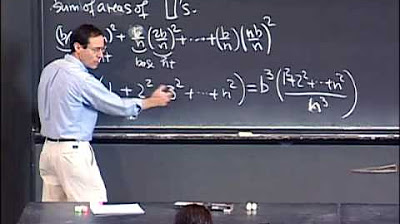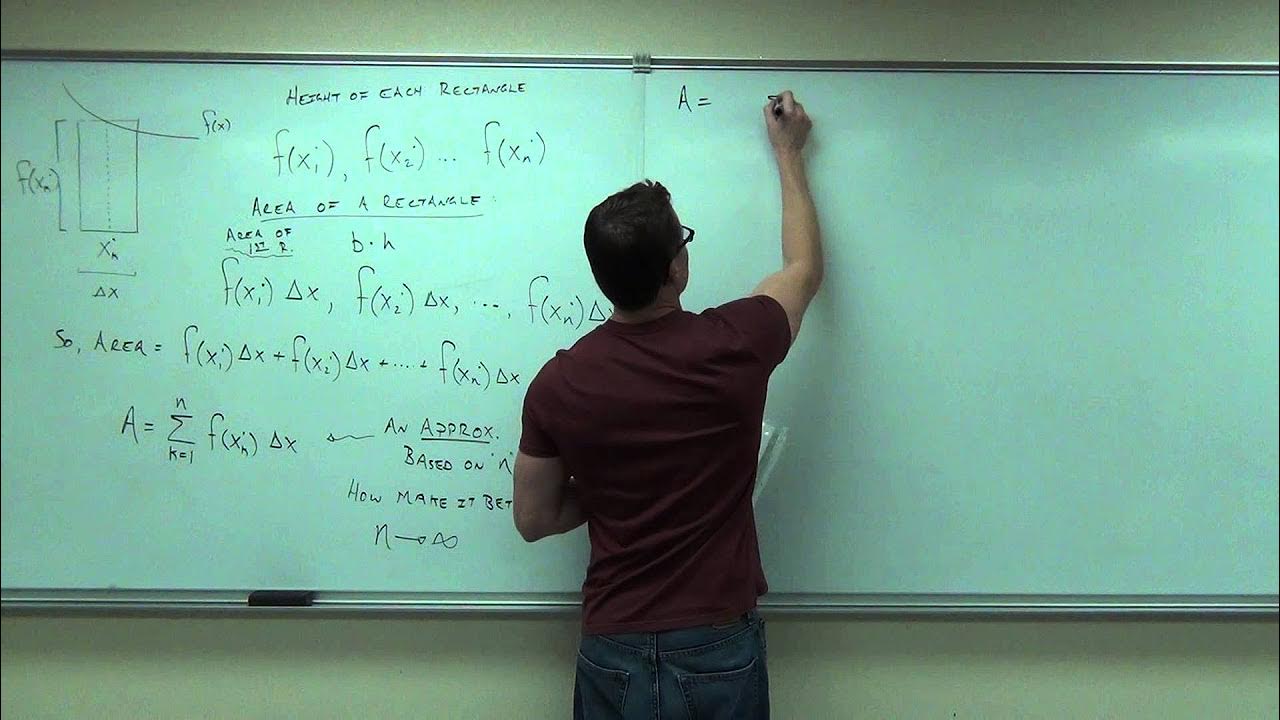Calculus AB/BC – 6.3 Riemann Sums, Summation Notation, and Definite Integral Notation
TLDRIn this educational video, Mr. Bean explores the concept of summation notation and its relation to Riemann sums, demonstrating how approximating areas under curves with rectangles can lead to precise calculations through calculus. By breaking down complex ideas into manageable parts, he illustrates the transition from summation to definite integrals, emphasizing the importance of understanding these fundamental concepts for mastering calculus.
Takeaways
- 📚 Summation Notation: The script introduces summation notation as a way to represent the addition of an infinite number of rectangles to approximate the area under a curve.
- 📈 Riemann Sums: Riemann sums are used to approximate the area under a curve by dividing the area into rectangles, each with a width (Δx) and height (f(x) at a specific point).
- 🔢 Approximation Improvement: As the number of sub-intervals (n) increases, the approximation of the area under the curve becomes more accurate, eventually converging to the actual area.
- 🤔 Infinite Rectangles: The concept of approaching infinity in the number of rectangles is discussed, where each rectangle's width (Δx) approaches zero, improving the approximation.
- 📊 Summation Formula: The script presents the summation formula for the area under the curve as Σ (Δx * f(x_i)), where i ranges from 1 to n, and x_i represents the points within each sub-interval.
- 🌟 Limit Concept: The idea of a limit is introduced as a way to handle the infinite number of rectangles in the summation, allowing for the calculation of the exact area under the curve.
- 🔄 Conversion Between Notations: The lesson emphasizes the ability to convert between summation notation and definite integrals, which is crucial for understanding calculus concepts.
- 📐 Definite Integral: The definite integral is introduced as a clean and concise way to represent the area under the curve, denoted by the symbol ∫ from a to b of f(x).
- 📝 Multiple Choice Application: The script suggests that on exams like the AP exam, students will often be given multiple-choice options to identify the correct definite integral from a summation series.
- 🔍 Checking Answers: The process of checking answers by converting a definite integral back into summation notation is discussed as a way to verify the correctness of an integral.
Q & A
What is the main topic of the lesson?
-The main topic of the lesson is summation notation and its relation to Riemann sums and the area under curves in calculus.
How does the approximation of the area under a curve improve as the number of sub-intervals increases?
-As the number of sub-intervals increases, the approximation of the area under the curve improves because the rectangles used in the Riemann sums become smaller and more numerous, leading to a closer representation of the actual area under the curve.
What is the significance of the limit in the context of summation notation?
-The limit is significant in summation notation as it represents the process of approaching infinity, which allows for the summation of an infinite number of rectangles to accurately approximate the area under a curve.
What does the width of each sub-interval (delta x) represent in the context of Riemann sums?
-The width of each sub-interval (delta x) represents the change in x, indicating how far apart the rectangles are in the Riemann sum approximation.
How is the summation notation written for the area under the curve?
-The summation notation for the area under the curve is written as the sum of the areas of all rectangles, represented by the formula: Σ (delta x * f(x_i)), where i ranges from 1 to n, and n is the number of sub-intervals.
What is the definite integral and how is it related to summation notation?
-The definite integral is a clean and concise way of representing the area under the curve, equivalent to the summation notation but without the need for explicitly writing out the sum of an infinite number of rectangles. It is denoted by the integral symbol (∫) with the lower and upper limits of integration.
How can you convert a definite integral into summation notation?
-To convert a definite integral into summation notation, you express the integral as the limit as n approaches infinity of the sum of the product of the width of each sub-interval (delta x) and the function value at each sub-interval (f(x_i)), where i ranges from 1 to n.
What is the purpose of learning both summation notation and definite integrals?
-The purpose of learning both summation notation and definite integrals is to be able to understand and convert between the two notations, which is essential for understanding the concepts of area under curves and the fundamental theorem of calculus.
How does the height of each rectangle in the Riemann sum approximation relate to the function value?
-The height of each rectangle in the Riemann sum approximation is determined by the function value (f(x_i)) at the points within each sub-interval.
What is the role of the variable 'k' in the summation notation?
-In the summation notation, 'k' represents the index for each sub-interval or rectangle, ranging from 1 to n, and is used to denote the specific rectangle in the sum.
How can you check if a given summation notation corresponds to a definite integral?
-To check if a given summation notation corresponds to a definite integral, you can identify the lower and upper limits of integration, the width of the rectangles (delta x), and ensure that the expression inside the summation matches the function to be integrated.
Outlines
📚 Introduction to Riemann Sums and Summation Notation
This paragraph introduces the concept of Riemann sums and summation notation in the context of calculus. Mr. Bean explains how Riemann sums can be used to approximate the area under a curve by summing up rectangles formed by dividing the interval into sub-intervals. The more sub-intervals used, the better the approximation becomes. The paragraph also touches on the idea of approaching infinity in terms of the number of rectangles, which leads to the concept of a definite integral.
📈 Understanding Summation Notation and Infinite Rectangles
In this paragraph, Mr. Bean delves deeper into summation notation, illustrating how it represents the process of adding up an infinite number of rectangles to find the area under a curve. He provides a step-by-step explanation of the summation formula, emphasizing the width (delta x) and the height (f(x)) of each rectangle. The paragraph also introduces the concept of the definite integral as a cleaner and more conventional way to represent the summation of areas under a curve.
🔢 Converting Definite Integrals to Summation Notation
This paragraph focuses on the process of converting definite integral expressions into summation notation. Mr. Bean provides examples of how to translate the integral of a function over an interval into a summation series, explaining the variables and operations involved. He also discusses different ways to write summation notation and how to verify the correctness of the integral by checking it against various possible expressions.
📊 Approximating Definite Integrals with Summation
Here, Mr. Bean demonstrates how to approximate definite integrals using summation. He uses the example of the cosine function to show how distributing a value across sub-intervals can approximate the integral. The paragraph emphasizes the importance of recognizing the relationship between series, sequences, and definite integrals, which is crucial for understanding the second half of calculus.
🎓 Mastery Check and Final Thoughts
In the concluding paragraph, Mr. Bean reflects on the importance of understanding the conversion between definite integrals and summation notation. He mentions that while this topic might only appear in a limited capacity on the AP exam, mastering it is essential for a comprehensive understanding of calculus. He encourages students to practice and recognize these concepts for their future studies in calculus.
Mindmap
Keywords
💡summation notation
💡Riemann sums
💡approximation
💡area under the curve
💡limit
💡delta x
💡definite integral
💡calculus
💡function value
💡interval
💡sub-interval
Highlights
Introduction to summation notation in relation to Riemann sums and approximating areas under curves.
Explanation of how increasing the number of sub-intervals improves the approximation of the area under a curve.
Discussion on the concept of approaching infinity in the context of summation and rectangles becoming infinitesimally small.
The formula for the width of each sub-interval (delta x) and its relationship with the number of rectangles.
Summation notation for the area under the curve using rectangles, expressed as a sum from 1 to n.
The transition from summation notation to the definite integral, which is a cleaner representation of the area under the curve.
Illustration of how to convert a definite integral back to summation notation for verification purposes.
Example given where the function f(x) = 2x + 1 is used to demonstrate summation notation over the interval from 3 to 5.
Explanation of the definite integral symbol and its interpretation as the area under the curve between interval limits.
Clarification that while summation notation can be complex, there are shortcuts in calculus for calculating definite integrals.
Demonstration of three possible definite integral expressions that all represent the same summation series.
Instructions on how to identify the correct definite integral from multiple choices for a given summation series.
Another example provided to convert a series into a definite integral approximation, using the cosine function over the interval from 0 to 1.
Emphasis on the importance of understanding the relationship between series, summation notation, and definite integrals for the study of calculus.
The lesson's goal is to ensure the ability to convert between summation notation and definite integrals, which are fundamental to calculus.
Transcripts
Browse More Related Video

Calculus 1: Area Between Curves Examples

AP Calculus AB: Lesson 6.2 Part 2 (Limit Definition of Definite Integral)

Lec 18 | MIT 18.01 Single Variable Calculus, Fall 2007

Calculus 1 Lecture 4.3: Area Under a Curve, Limit Approach, Riemann Sums

Calculus 1: Definition of the Integral Examples

Business Calculus - Math 1329 - Section 5.3 - The Definite Integral and Fundamental Thm of Calculus
5.0 / 5 (0 votes)
Thanks for rating: